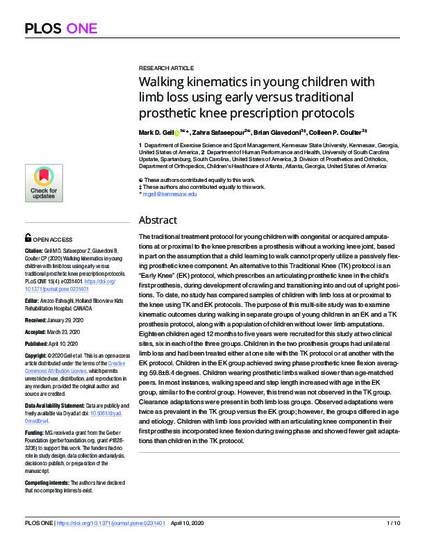
The traditional treatment protocol for young children with congenital or acquired amputations at or proximal to the knee prescribes a prosthesis without a working knee joint, based in part on the assumption that a child learning to walk cannot properly utilize a passively flexing prosthetic knee component. An alternative to this Traditional Knee (TK) protocol is an “Early Knee” (EK) protocol, which prescribes an articulating prosthetic knee in the child’s first prosthesis, during development of crawling and transitioning into and out of upright positions. To date, no study has compared samples of children with limb loss at or proximal to the knee using TK and EK protocols. The purpose of this multi-site study was to examine kinematic outcomes during walking in separate groups of young children in an EK and a TK prosthesis protocol, along with a population of children without lower limb amputations. Eighteen children aged 12 months to five years were recruited for this study at two clinical sites, six in each of the three groups. Children in the two prosthesis groups had unilateral limb loss and had been treated either at one site with the TK protocol or at another with the EK protocol. Children in the EK group achieved swing phase prosthetic knee flexion averaging 59.8±8.4 degrees. Children wearing prosthetic limbs walked slower than age-matched peers. In most instances, walking speed and step length increased with age in the EK group, similar to the control group. However, this trend was not observed in the TK group. Clearance adaptations were present in both limb loss groups. Observed adaptations were twice as prevalent in the TK group versus the EK group; however, the groups differed in age and etiology. Children with limb loss provided with an articulating knee component in their first prosthesis incorporated knee flexion during swing phase and showed fewer gait adaptations than children in the TK protocol.
Available at: http://works.bepress.com/mark-geil/2/

This article received funding through Kennesaw State University's Faculty Open Access Publishing Fund, supported by the KSU Library System and KSU Office of Research.